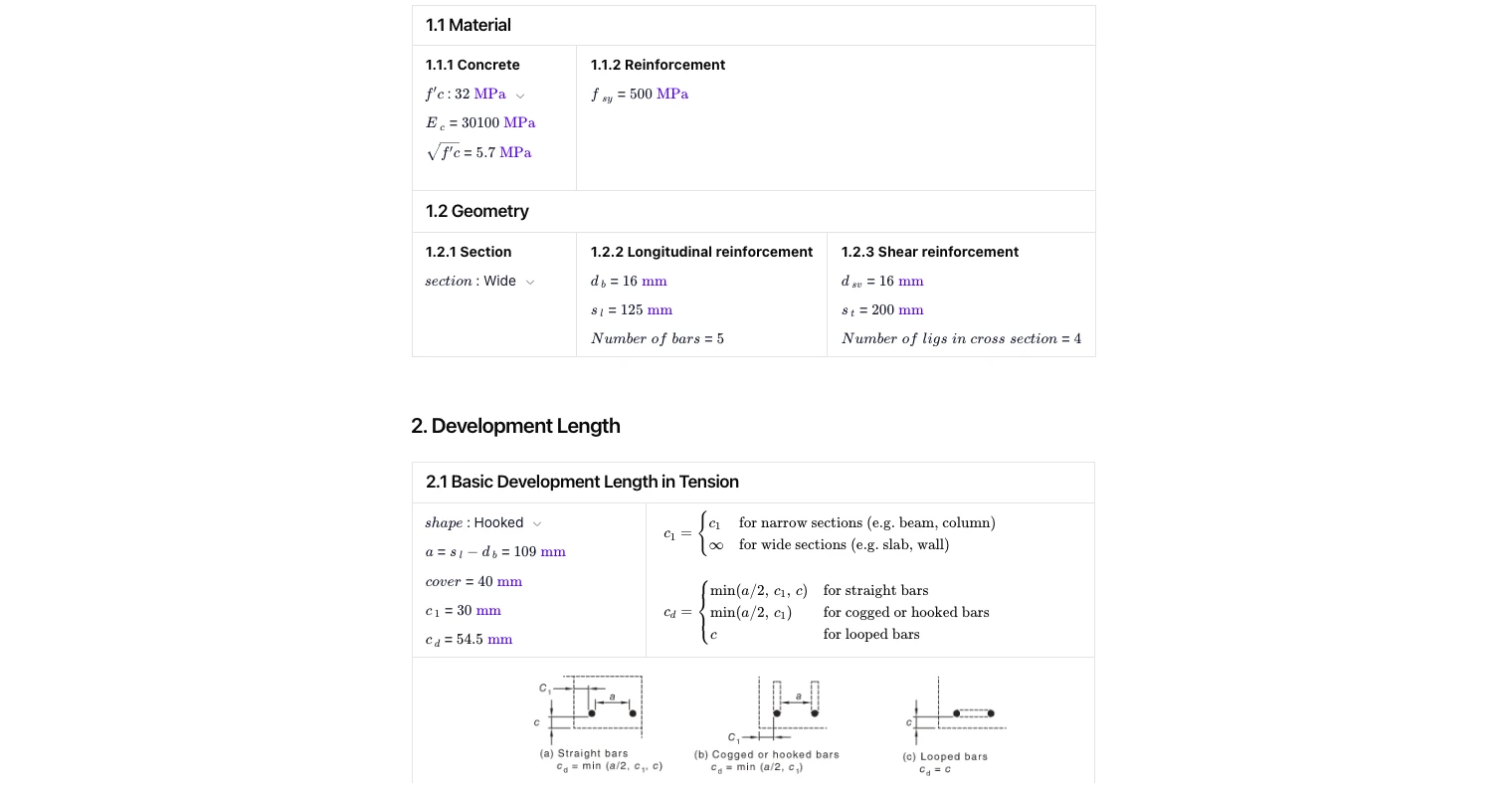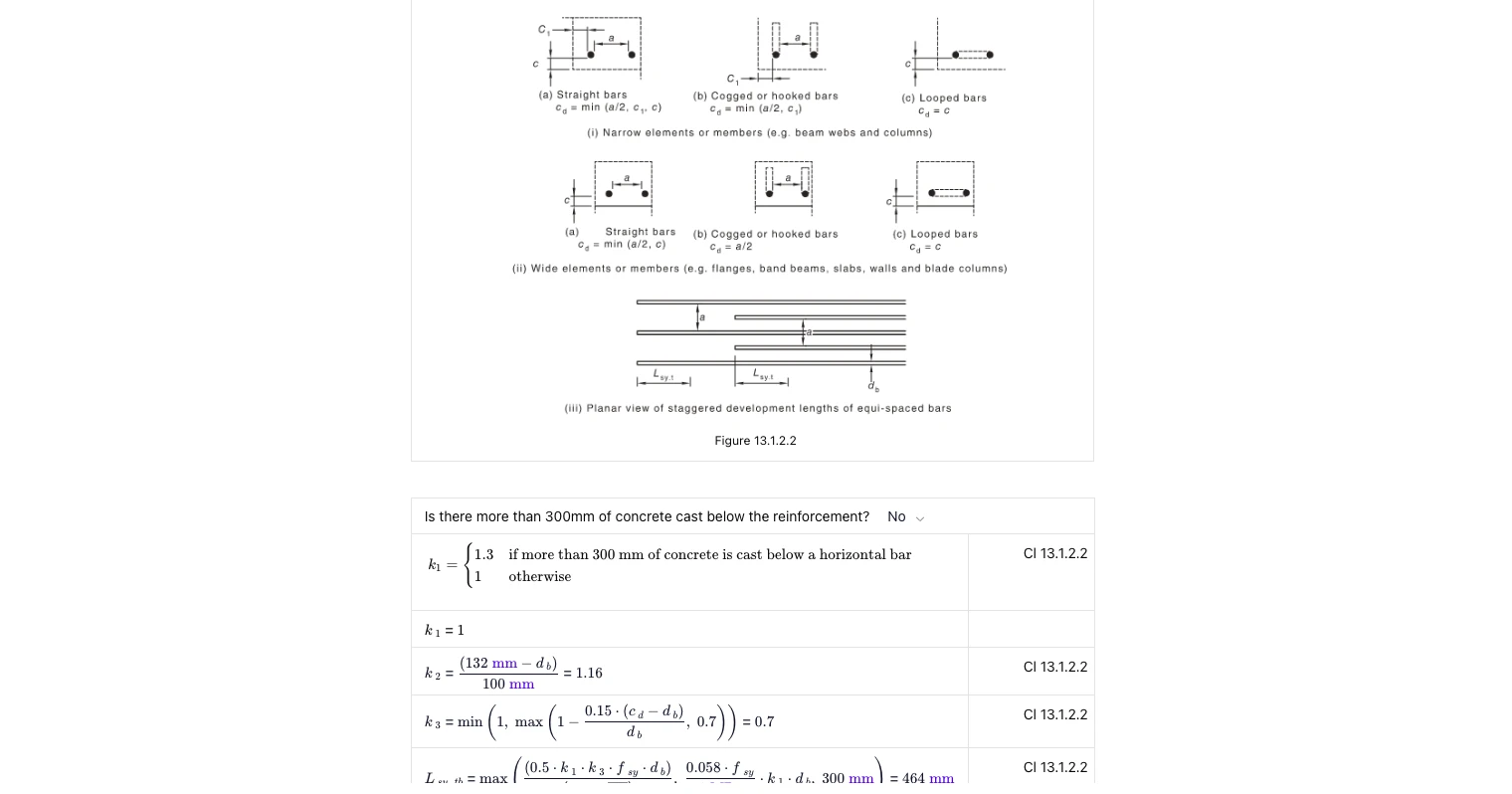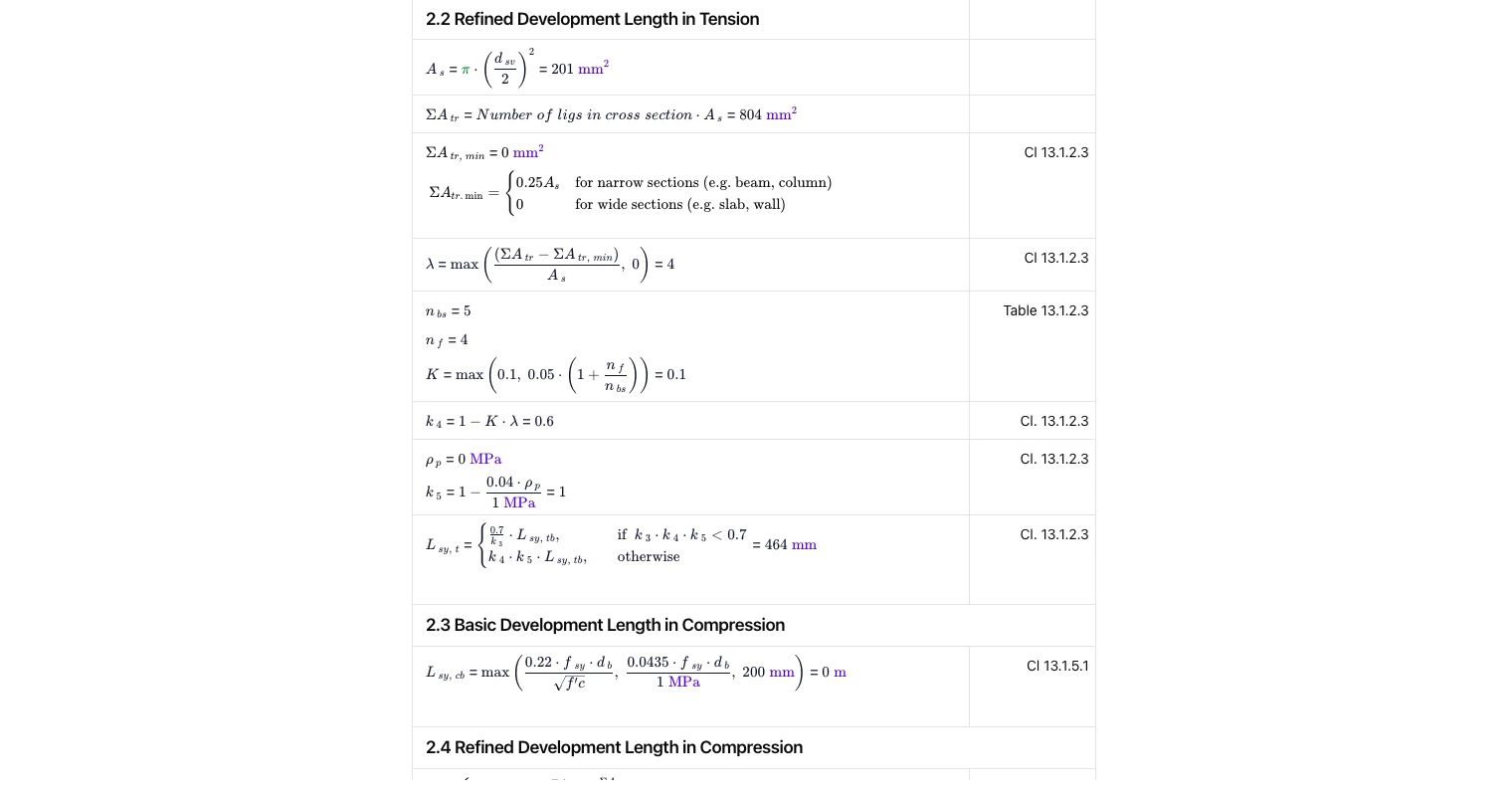Engineering-grade AS 3600 development length calculator for tension and compression bars, including refined checks with transverse reinforcement. Try it on Calc

This template is not available yet. You can sign up and create it yourself!
Or let us know if you'd like to be notified when it’s ready:
About this Reinforcement Development Length to AS 3600 Calculator
This calculator determines the minimum development (anchorage) length for reinforcing bars in tension and compression per AS 3600:2018. It covers both the basic and refined methods, accounting for cover, bar spacing, section type, bar shape, and transverse reinforcement.
- Structural engineer — size tension and compression laps/terminations in beams, slabs, walls, and columns to AS 3600 without hand-checking every modifier.
- Design checker — verify submitted bar schedules with a transparent summary of inputs, factors, clauses, and figures from the standard.
- Detailer / BIM technician — confirm bar hooks, cogs, and confinement are sufficient before issuing shop drawings.
Built on CalcTree’s unit-aware, engineering-grade engine, this template provides auditable clauses and step-by-step factors so results are reproducible and easy to review.
More info on Reinforcement Development Length to AS 3600
Inputs
- Material: concrete strength and modulus; reinforcement yield strength.
- Geometry: section type (narrow vs wide), bar diameter and spacing, number of bars/faces, concrete cover distances used to derive the controlling clear distance to the bar.
- Transverse reinforcement: lig/stirrup diameter, spacing, and number of legs engaged in the cross-section (used to form the confinement area sum).
- Bar shape: straight, cogged/hooked, or looped; selector drives which clear-distance rule applies for the controlling cover term.
Basic development length in tension
The basic tension development length is taken as the governing maximum of code expressions that combine:
- bar diameter and steel strength,
- modifiers for concrete cast below a horizontal bar, bar spacing/cover, and section type (commonly expressed as factors k1, k2, k3),
- a code minimum anchorage length.
Figures are embedded to show the controlling clear distance for straight, hooked/cogged, and looped bars, and how narrow vs wide sections affect the cover term (AS 3600 Fig. 13.1.2.2 logic reflected in-app).
Refined development length in tension
When transverse reinforcement is present, the calculator applies the refined method (Clause 13.1.2.3), which:
- computes leg area and sum of engaged transverse areas within the development zone,
- calculates the minimum required confinement sum based on section type,
- determines confinement and pressure reduction factors (typically noted as λ, K, k4, k5),
- adjusts the basic length up or down depending on whether the combined modifier product is below a threshold.
The result provides both basic and refined tension development lengths for side-by-side comparison in the summary table.
Basic development length in compression
For compression bars (Clause 13.1.5.1), the basic length is the maximum of code expressions that scale with bar diameter and steel strength and include the concrete strength term. A code-specified minimum also applies.
Refined development length in compression
If adequate transverse reinforcement is provided along the development length, a confinement factor (commonly expressed as k6) reduces the basic compression length per Clause 13.1.5.4. The tool checks the provided transverse reinforcement against the minimum required engagement before applying any reduction.
Common Calculation Errors to Avoid
- Ignoring section type (narrow vs wide) — the controlling clear distance switches with section classification; using the wrong one leads to unconservative development length in tension.
- Forgetting the “concrete cast below bar” modifier — horizontal bars with significant concrete below them require a higher modifier; skipping it can under-estimate anchorage.
- Using hook/cog rules for straight bars (or vice-versa) — the controlling cover/spacing term differs by bar shape; ensure the selector matches detailing.
- Counting the wrong number of transverse legs — refined tension/compression methods rely on the sum of engaged legs in the cross-section; over-counting yields non-compliant reductions.
- Applying refined reductions without meeting minimum confinement — if the minimum transverse area threshold is not satisfied, do not apply k4/k5/k6 reductions.
- Mixing bar diameter units — keep bar size, cover, and spacing in consistent units; CalcTree is unit-aware, but manual transpositions can introduce errors outside the app.
- Using tension rules for compression bars — compression development has different governing expressions and limits in AS 3600.
Engineering templates
Common calculators
Design guides
FAQs
What’s the difference between basic and refined development length in tension?
The basic method applies base modifiers for cover, spacing, section type, and casting position. The refined method incorporates transverse reinforcement confinement and, when satisfied, can reduce the required length in accordance with AS 3600.
How does the calculator classify “narrow” vs “wide” sections?
It follows AS 3600 definitions used for development length. This choice changes which clear-distance rule controls and is reflected in on-page figures and the c-term logic.
Do hooks/cogs automatically reduce the tension development length?
Not automatically. Hooks/cogs change the controlling cover/spacing term and can influence the governing expression, but the result still comes from the code-based maximum including minimums and modifiers.
How is transverse reinforcement “engagement” determined?
The tool sums the area of legs that effectively restrain the bar group within the development zone at the specified spacing. It then compares this sum to the code-required minimum before applying confinement factors in the refined method.
Does the tool check compression bars with confinement?
Yes. It computes a basic compression development length and then applies the compression refinement when the provided transverse reinforcement meets the minimum requirement along the anchorage length.
Can I use this for lap splices as well?
Development length is foundational to lap splice design. Use this result together with AS 3600’s splice provisions and bar placement rules. You can model both cases quickly in this template and store the calculation results.
Learn about the benefits of using CalcTree on engineering projects!













